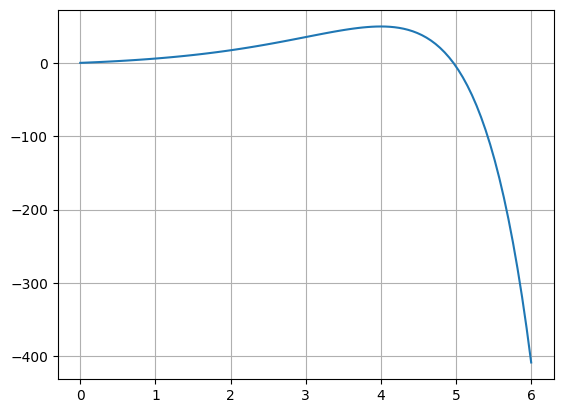Application: Wien’s law#
Wien’s law relates the temperature of a blackbody to the wavelength of peak emission. It has the form:
\[\lambda_\mathrm{max} T = b\]
where \(b\) is a constant.
Here we’ll find that constant.
As before, the Planck function describes the intensity of a blackbody:
\[B_\lambda = \frac{2h c^2}{\lambda^5} \frac{1}{\exp\left(\frac{hc}{\lambda k_B T}\right) -1}\]
defining
\[x = \frac{hc}{\lambda k_B T}\]
we have
\[B = \frac{2 (k_B T)^5}{h^4 c^3} \frac{x^5}{e^x - 1}\]
To find the maximum, we set \(dB/dx = 0\), giving:
\[\frac{dB}{dx} =- x^5 (e^x - 1)^{-2} e^x + \frac{5x^4}{e^x - 1} = 0\]
or
\[(5 - x )e ^x - 5 = 0\]
Let’s plot this.
import numpy as np
import matplotlib.pyplot as plt
def f(x):
return (5 - x) * np.exp(x) - 5
fig, ax = plt.subplots()
x = np.linspace(0, 6, 100)
ax.plot(x, f(x))
ax.grid()

This clearly has a root close to \(x = 5\).
We’ll find it via bisection
def bisect(xl, xr, func, tol=1.e-8):
"""find the zero of func(x) in the interval [xl, xr]"""
# first check if there is a root in the interval
fl = func(xl)
fr = func(xr)
if fl * fr > 0:
print("no root in the interval")
return None
# now setup our iteration loop. We will keep looping until
# the relative error is < tol
err = 1.e10
xm = 0.5 * (xl + xr)
while err > tol:
fm = func(xm)
if fl*fm > 0:
# the root is in the right half of the interval
xl = xm
fl = fm
else:
# the root is in the left half of the interval
xr = xm
fr = fm
xm = 0.5 * (xl + xr)
err = np.abs(xr - xl) / np.abs(xm)
return xm
x0 = bisect(1, 5, f)
x0
4.9651142209768295
Now we bring this back to physical units. Note that:
\[\lambda T = \frac{hc}{k} \frac{1}{x}\]
k = 1.38e-16 # erg /K
c = 3e10 # cm/s
h = 6.63e-27 # erg s
print(h*c/k/x0)
0.29028624190291574
This shows that
\[\lambda_\mathrm{max} T = 0.29~\mbox{cm~K}\]


